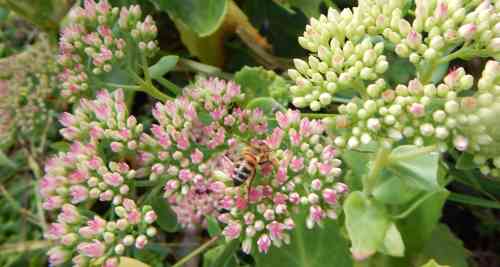The World's Largest Known Bee, Megachile Pluto, Wallace's Giant Bee
The world's largest bee thus far discovered, is a type of leafcutter, called Megachile pluto - also known as Wallace's giant bee.
Read on to find out more about this amazing species!
7 Fascinating Facts About The World's Largest Known Bee: Megachile Pluto (Wallace's Giant Bee)
 Female Megachile pluto
Female Megachile pluto- The 'Wallace's giant bee was so named in a nod to its discoverer, Alfred Russel Wallace, a British entomologist and contemporary of Charles Darwin, who first recorded the bee in 18591.
- This amazing bee lives in the arboreal nests of termites (i.e. termite nests found in trees)2.
- Female bees are larger than males. Females may reach a length of 38 mm (1.5 in.), with a wingspan of 63.5 mm (2.5 in.) Males on the other hand are smaller, and grow to about 23 mm (0.9 in) long.
- Females have very large jaws (mandibles). It's discoverer, Alfred Wallace described it as “a large black wasp-like insect, with immense jaws like a stag-beetle”1.
These large jaws are used for gathering and carrying resin from trees along with wood fibres.
The resin is used to line the nest tunnels and chambers inside the termite nest2. The resin lining may prevent termites from entering the bee's nest. - The Wallace's giant bee is rare, and is included on the IUCN's red list of endangered species3.
- This species has only ever been found in 3 islands in Indonesia3.
- The local people in regions where this bee is found refer to it as Ó ofungu ma kÓana - or “king bee”2.
Nests
Nests occur just below the outer surface of a termite nest, and are excavated by females. The females collect both wood fibers and plant resins which they use to construct waterproof brood cells inside the excavated tunnels and chambers.
Brood cells are provisioned with a mixture of pollen and nectar, ready to be consumed by a developing larva once it emerges from an egg.
The strong mandibles along with the labrum (upper lip) of the female, help her to gather resin from tree trunks, an action described by Mess (1984)2 as follows:
"Facing upward, a female loosened resin with the mandibles, then scraped it up using the elongate labrum in the manner of a bulldozer blade. The ball of resin, which formed was held in place between the tree and the labrum while being progressively enlarged. The process was repeated until a ball approximately 10mm in diameter had been amassed".
Females may share nests but each female constructs and provisions her own brood cell4.
Below is a video of a Megachile pluto nest in a termite mound. A single bee enters the nest via a hole on its surface. Males typically exhibit territorial behaviours around nests.
Why the world's largest known bee species is under threat
Given the bee's status on the IUCN red list, conservation efforts are urgently needed to increase and stabilise populations.
But what are the factors threatening these giant bees?
1. Deforestation
Sensitive wildlife habitats of the Indonesian islands are themselves under threat from deforestation. Given that the Wallace's giant bee relies on the tree nests of a particular termite species (Microcerotermes amboinensis)2, it is vulnerable to loss of required termite habitat (trees).
In fact, in 2001, Indonesia had 93.8Mha of primary forest, extending over 50% of its land area. Twenty years later, it had lost 203kha of primary forest5.
2. High ecological specialization coupled with narrow distribution2
Even without the threat of deforestation, the high ecological specialization of this species alone increases its vulnerability (highly adaptable species in terms of habitat, nesting and food requirement are repeatedly shown to be less vulnerable to environmental changes and are generally more likely to be wide spread).
3. Illegal trade
Removing Megachile pluto from any of the Indonesian islands is likely to be contrary to Indonesian laws6. However, once smuggled out of the islands, they may be traded quite legally, since they are currently not listed in CITES (Convention on International Trade in Endangered Species of Wild Fauna and Flora. It has been proposed that Megachile pluto be added to CITES4.
4. Low fecundity
According to limited records, the number of offspring reared in a single nest may be relatively low, with a nest containing only six individual females and 22 developing larvae. Furthermore, Megachile pluto nests were found in only a few of the termite nests inspected2.
References
1. Wallace AR (1869) The Malay Archipelago: The land of the orangutan, and the bird of paradise. A narrative of travel, with sketches of man and nature (1st edition). Macmillan, London.
2. Messer, Adam Catton. “Chalicodoma Pluto: The World’s Largest Bee Rediscovered Living Communally in Termite Nests (Hymenoptera: Megachilidae).” Journal of the Kansas Entomological Society, vol. 57, no. 1, 1984, pp. 165–68. JSTOR, http://www.jstor.org/stable/25084498. Accessed 23 Aug. 2022.
3. Vereecken, N.J. Wallace’s Giant Bee for sale: implications for trade regulation and conservation. J Insect Conserv 22, 807–811 (2018). https://doi.org/10.1007/s10841-018-0108-2
4. Cornell University: Look what we found in the collection! – Megachile pluto Dec 4, 2019 | News.
5. https://www.globalforestwatch.org/
6. The world's largest bee 'rediscovered' after 38 years - Natural History Museum, London 2019.
If you found this page helpful or interesting, I'd really be grateful if you would share it with others - if not this page, perhaps another, such as Gardening For Bees.
Thank you so much :) .


